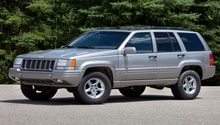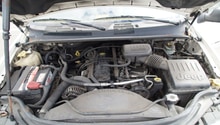Jeep Cherokee 1984-2001: Why is My Car Running Hot?
There is not much worse than your Cherokee running hot. We can help you get the situation under control.
This article applies to the Jeep Cherokee XJ (1984-2001).
Your Jeep is supposed to get warm to run at peek efficiency. The cooling system consists of a liquid medium to provide heat transfer, a pump in order to pump the liquid through the engine, a thermostat that regulates flow through the system (based on temperature), a radiator to dissipate the heat to the outside, assorted hoses, and a fan to bring cool air through the radiator. Getting too hot can cause problems like busted hoses, boiling coolant out of the radiator, poor performance, and even cracking or warping the head. Some of the reasons are too simple, while others will make you think. Let's go ahead and find the problem.

Materials Needed
- Coolant
- Catch pan
- Assorted English wrenches and sockets
- Coolant system flush kit
Step 1 – Check your coolant
This is one of those start at the start things.
Your cooling system can not work without a medium to transfer the heat from the engine to the outside air. A 50/50 mix of antifreeze and water is recommended for your vehicle. The system must be full of coolant to work best. It is easy to look at the overflow bottle and say that you checked the coolant, which is acceptable if the system is fine, but sometimes you have to take the radiator cap off (ONLY if the engine is cool and use caution) to look inside of the radiator in order to check the level.

Pro Tip
This is also a good time to check the upper and lower radiator hoses. They should feel firm, and not squishy.
If your level is acceptable, then let's look at another thing.
Step 2 – Check the cooling fan
Electric or mechanical, it has to work.
If your Cherokee has an electric fan, watch that it turns on and operates. It is controlled by a switch screwed into the engine. If you have a fan driven by the engine, it came with a fan clutch from the factory. At start up and when cold, the clutch should let the fan free wheel, but when the engine warms up, the clutch should sense that it needs to lock up.
Pro Tip
It is a good idea to be sure the radiator is not clogged with dirt. You can spray water through it with a hose to wash it out.
Related Articles
- How to Flush Your Cooling System - CamryForums.com
- How to Replace Radiator - CamryForums.com
If your coolant fan is not the issue, move on to Step 3.
Step 3 – Look for coolant flow
Your coolant has to flow to transfer the heat.
Since you have your radiator cap off, start your engine and carefully look in the radiator. You should be able to see the coolant circulating. If you rev the engine up, the flow should be even more pronounced. If you see no flow, then there is a clog or the water pump is faulty.
Pro Tip
Flushing the cooling system is a wise maintenance item.
If the thermostat is stuck closed, there will be no coolant flow.
Step 4 – Check thermostat
A bad thermostat is an easy fix.
About the only way to check your thermostat is to remove it. The housing is held on with two bolts. The thermostat is behind the housing. Thermostats are cheep and now is the time to replace it.

Pro Tip
Replace your thermostat with the same opening temperature or slightly cooler.
(Related Article: How to Replace Thermostat - CamryForums.com)
If the thermostat is good, the water pump in now a suspect.
Step 5 – Replace water pump
A bad water pump can actually inhibit flow.
The impeller on your original water pump may have been made of plastic. With age they have been known to lose teeth, which means they can not pump. Some were sheet metal that rust away. You can only tell for sure by replacing the pump.

Pro Tip
A bad water pump can be noisy, not pump, and leak, but not all of the time.
If the steps above did not show a problem, it may get ugly.
Step 6 – Check for a cracked head
If your Cherokee has overheated this could happen.
The engine in your Jeep is tried and true. Overheating once might not cause any harm, but if the head gets too hot, it can crack. The block holds a lot of coolant, but the head does not. A blown head gasket can act the same way. To see if the head is cracked, you can look at:
- The engine oil to see if it is milky or the coolant has oil in it.
- A lot of water comes out the exhaust.
- A compression test shows low.
If these conditions describe your engine, you're looking at an incoming engine rebuild.

Figure 4. Oil in coolant. 
Figure 5. Coolant in oil.
Related Discussions
- Everyone Whose Jeep Runs Hot - CherokeeForum.com
- Runs, Then Shuts Off When Hot - CherokeeForum.com
- Stalling Due to Overheating - CherokeeForum.com
- Coolant Spewing From Radiator Cap When Cold - CherokeeForum.com
- Need Help, Jeep Overheating - CherokeeForum.com






